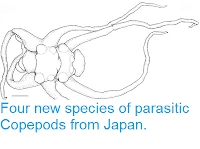Copepods are minute Crustaceans found in almost all aquatic environments, from the deepest ocean trenches, to films of water on patches of Moss. Free-living Copepods typically have a short, cylindrical body, with a rounded or beaked head. The body is comprised of a head which is fused with the first one or two thoracic segments, followed by three-to-five limb-baring free thoracic segments, then five abdomen segments and a pair oftail-like rami. A wide variety of parasitic Copepods also exist, with extremely variable body-plans. Members of the Order Cyclopoidia are free-living Copepods, predominantly living as members of the plankton in both marine and freshwater environments, though members of the Family Schminkepinellidae, which comprises marine Copepods found in deepwater environments and caves, are often benthic.
In a paper published in the journal ZooKeys on 22 July 2019, Viatcheslav Ivanenko of the Department of Invertebrate Zoology at Lomonosov Moscow State University, Jimin Lee of the Marine Ecosystem Research Center at the Korea Institute of Ocean Science & Technology, Cheon Young Chang of the Department of Biological Science at Daegu University, and Il-Hoi Kim of the Korea Institute of Coastal Ecology, describe a new species of Schminkepinellid Copepod from the Onnuri Vent Field on the Central Indian Ridge in the Indian Ocean.
The new species is placed in the genus Barathricola, which currently contains only a single species, Barathricola rimensis, from a hydrothermal vent field on the Juan de Fuca Ridge in the north Pacific, and given the specific name 'thermophilus' meaning 'lover of heat' in reference to the fact that it was found in a hydrothermal vent field. Barathricola thermophilus is described from nine male and seven female specimens collected from sediments at a depth of 2022 m.
Barathricola thermophilus, female: (A) habitus, dorsal (B) urosome, dorsal (C) right caudal ramus, ventral (D) spermatophore (E) rostrum (F) antennule (G) antenna (H) mandible (I) maxillule. Scale bars: 0.1 mm (A) 0.05 mm (B) 0.02 mm (C)–(I). Ivenko et al. (2019).
Females of Barathricola thermophilus range from 700 to 776 μm in length. There are four limb-baring free thoracic segments, followed by a narrow five segmented abdomen. Males are smaller and narrower than the females.
See also...
Follow Sciency Thoughts on Facebook.






